
5 Onsens said to be the model for Ghibli's Spirited Away
The Aburaya is run by an old witch. Various Japanese gods visit the Aburaya to relieve their daily fatigue in the onsen. The story, with its mysterious worldview and fascinating characters, has become a topic of conversation not only in Japan but also around the world.
Studio Ghibli has not officially disclosed the onsen ryokan or onsen resort that served as the model for the film. Even if they are not officially acknowledged as having influenced the production, there are places throughout Japan that are reminiscent of the work. In this article, we will introduce five onsen resorts that are said to have served as models in this work!
Shima Onsen, Gunma
Shima Onsen in Gunma Prefecture is a historic onsen that is said to have opened during the Heian Period (794-1185). Surrounded by mountains, the onsen resort is located along the Shima River. It is said that the long-established ryokan (Japanese-style inn) in Shima Onsen and the vermilion-lacquered Keiun Bridge over the river in front of the ryokan are the models for the movie.
.webp)
Built in 1691, the long-established ryokan is the oldest wooden yuyado building in Japan. The ryokan consists of three buildings, connected by tunnels and stairs along the slope of the mountain. The tunnel connecting the main building to the elevator creates an atmosphere of a different world beyond.
At the beginning of the film, Chihiro and her family pass through a tunnel that connects the world of the gods and the real world. The tunnel in the ryokan looks like a tunnel from a movie, as if you could get lost in another world.
After passing through the tunnel, Chihiro and her parents are fascinated by the mysterious atmosphere of the city. In contrast to Chihiro, who wants to go home, her parents start eating delicious-looking food at a store with no staff. Leaving her parents at the store, Chihiro strolls through the town until she comes to a bright red bridge. On the other side of the bridge stands the mysterious "Aburaya" onsen inn.
The vermilion-lacquered Keiun Bridge and the appearance of the ryokan are reminiscent of the bright red bridge and onsen inn "Aburaya" that Chihiro reached. The ryokan is lit up at night, creating a fantastic and romantic atmosphere that is different from that of the daytime.
.webp)
In the Aburaya featured in the film, a potent medicinal onsen was used to relieve the fatigue of all gods. "Shima" in Shima Onsen means 40,000. The name comes from the legend that Shima Onsen is a "sacred spring that cures 40,000 diseases".
There are two theories about the origin of Shima Onsen. One is that a warlord, Tamuramaro Sakanoue , bathed in the onsen during the Heian period (794-1185), and the other is that a warlord, Sadamitsu Usui, discovered the onsen.
In this area, onsen inns began to be established in the 16th century, and by the 17th century, the prototype of the current onsen resort took shape. In 1954, the area was designated as the first National Recreational Onsen Resort. The Minister of the Environment designates onsen resorts that not only have an abundant supply of onsens and the full benefits of onsens, but also have excellent scenery and environment.
.webp)
Since ancient times, onsens have been loved by many people because they are said to be good for the stomach if drunk and good for the skin if bathed in. They are also good for cuts, neuralgia, and recovery from fatigue. Because it is good for gastrointestinal diseases, there are public drinking fountains and inns that have their own drinking fountains.
Shibu Onsen, Nagano
The "Kanaguya" of Shibu Onsen in Nagano Prefecture is a long-established onsen ryokan founded in 1758. It is said that the gleaming golden exterior of the "Saigetsuro" at night looks very much like the Aburaya in the movie.

Before the Kanaguya started the onsen inn, it ran a blacksmith shop. It is said that he started a onsen resort after a landslide in the mountains behind his business caused an onsen to gush forth from his property during reconstruction. The number of guests increased as the blacksmith shop was closed down and the inn specialized in onsens, and many people visited the inn during the war.
The four-story wooden "Saigetsuro" building was registered as a Tangible Cultural Property of Japan in 2003, along with the "grand room" building. Both buildings are still in use as they were when they were built in 1936. The ryokan not only preserves the buildings, but also operates as an inn that conveys the onsen culture of the time.
At night, the Saigetsuro glitters and sparkles under the lights. The interior of the ryokan, which is decorated in a Western style, also conveys the unrealistic view of the world of Aburaya. The bengara-painted walls and the wooden grand room are like a scene from a movie in which Kaonashi runs around looking for Chihiro.
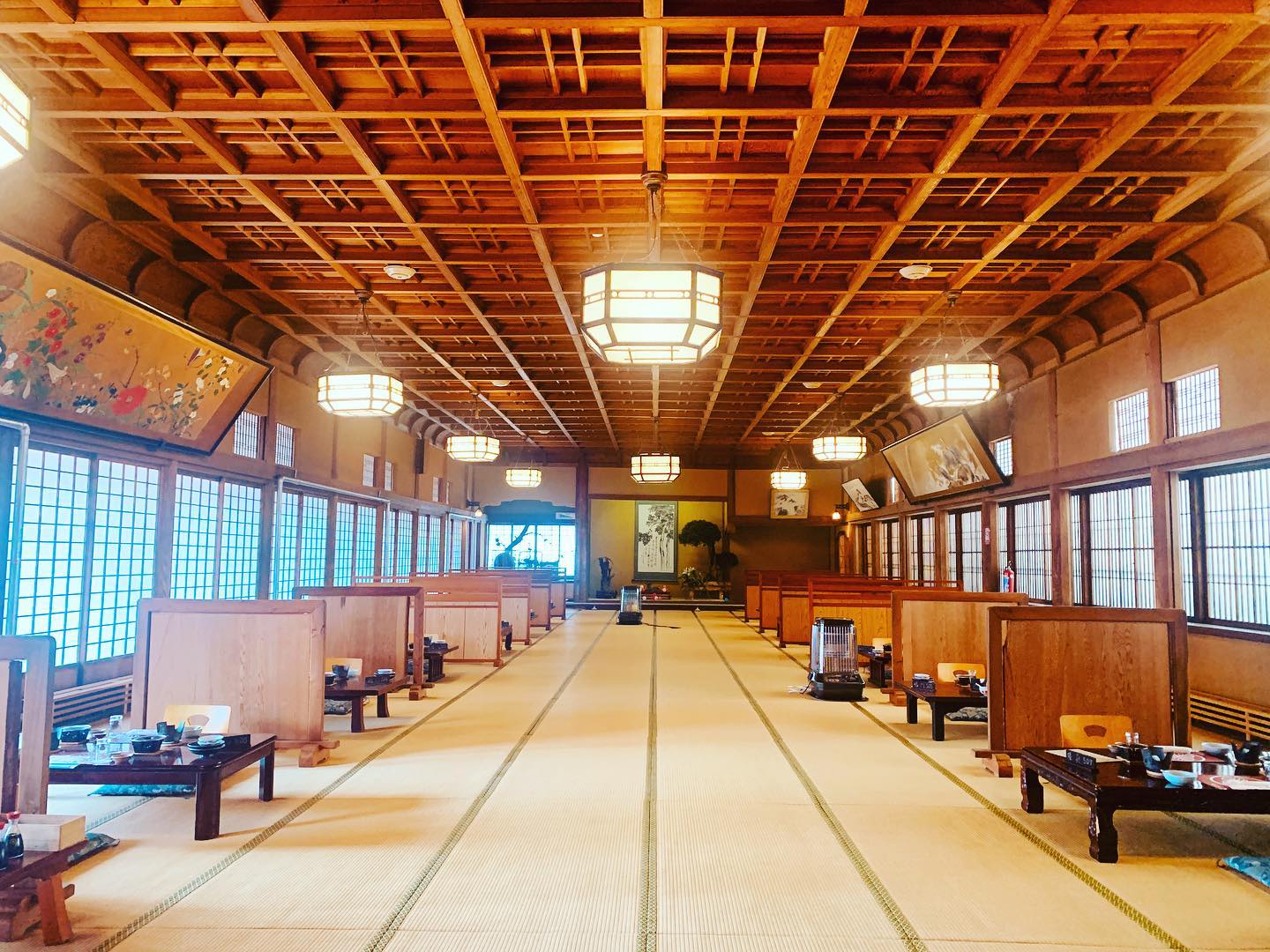
Kanaguya has three large baths and five private baths, for a total of eight baths. The hot water is 100% free-flowing volcanic high hot-spring water. All of the hot water from the onsens, including that from the faucets, is onsen water itself.
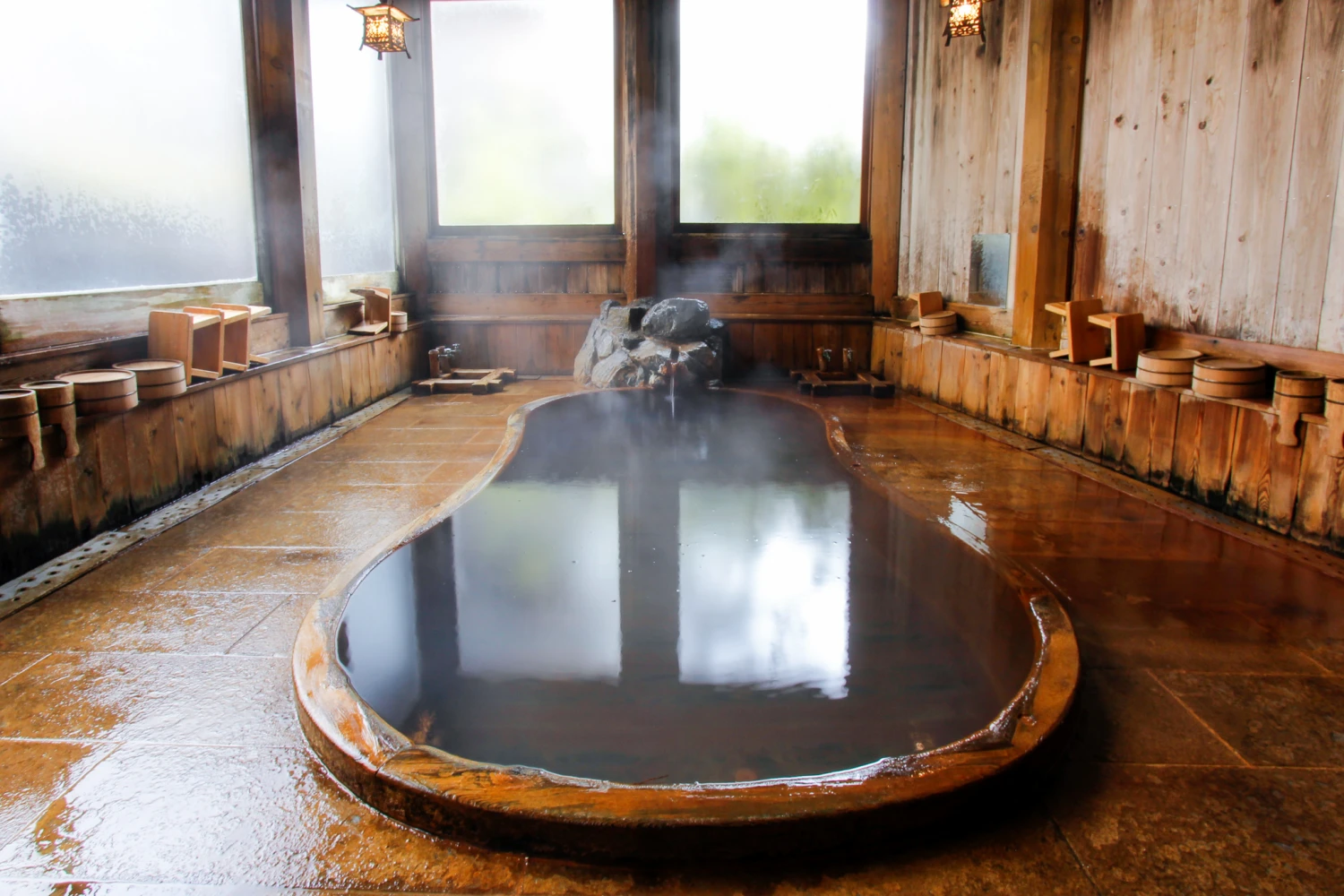
The ryokan has four private onsen sources, including the one that inspired Kanaguya to establish the onsen ryokan. The oldest private onsen is the one that inspired the founding of the onsen ryokan. It is a muddy yellowish onsen with high iron content and is said to be good for the skin. Three large baths with different qualities of spring water can be enjoyed by visiting different baths. There is an open-air bath on the rooftop and two indoor baths with different interior decorations. The clear, colorless water in the open-air baths is slightly alkaline and effective for beautiful skin.
Dogo Onsen, Ehime
Dogo Onsen, located in Matsuyama City, Ehime Prefecture, is the oldest and most famous onsen in Japan. The symbol of Dogo Onsen, which boasts a history of approximately 3,000 years, is the Dogo Onsen Honkan. What catches the eye at the front entrance of the Dogo Onsen Honkan is the distinctive rounded shape of the roof in the center. It is said that the rounded roof of the onsen ryokan "Aburaya" from the movie and the dignified appearance of the building are very similar to the Dogo Onsen Honkan.
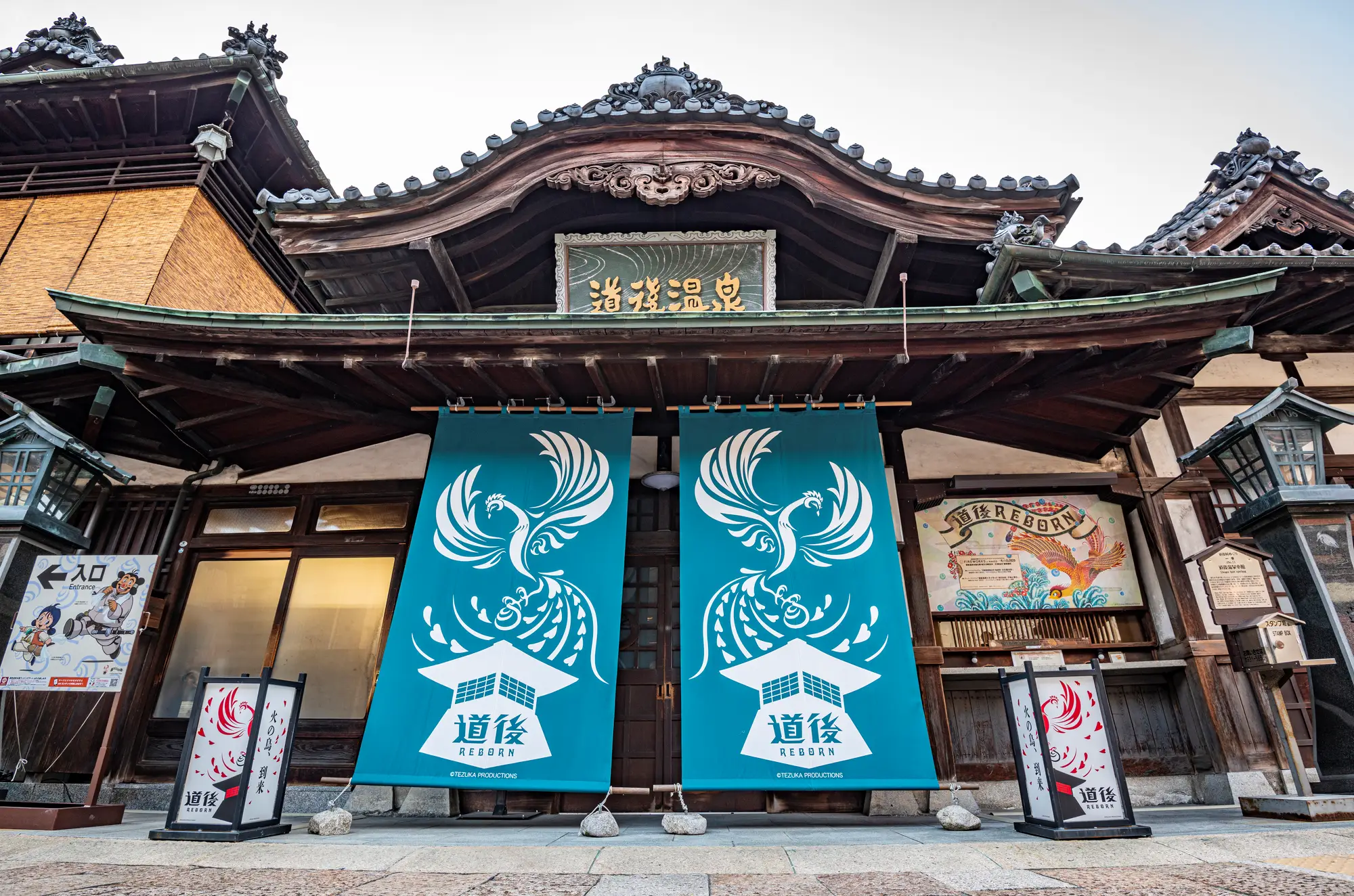
Various Japanese deities visit Aburaya, the film's setting, to heal their bodies. Legend has it that Japanese deities actually healed their illnesses by bathing in the onsens at Dogo Onsen.
In ancient times, two gods, Okuninushi-no-Mikoto and Sukunahikona-no-Mikoto, came to Ehime Prefecture, and Sukunahikona-no-Mikoto became seriously ill and fell asleep. When Sukunahikona-no-Mikoto, who was suffering from a serious illness, took a bath in Dogo Onsens, he immediately recovered and danced on a stone. This stone is called "Tama-no-ishi" and is dedicated on the north side of the Dogo Onsen Honkan. The stone has footprints that were left behind when Sukunahikona-no-Mikoto stood up.
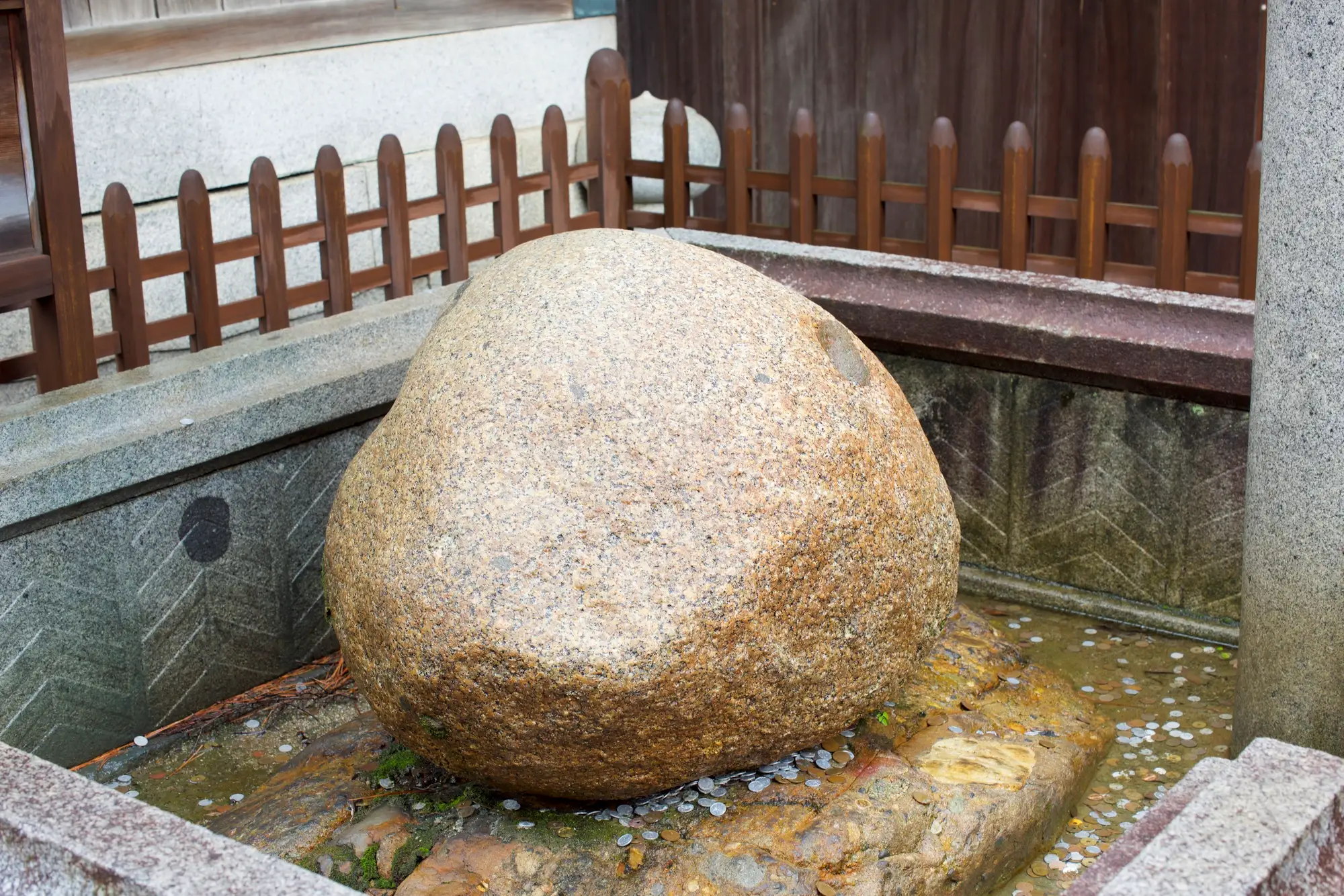
The onsen, which is said to have healed the illness of a god, is well known and loved by locals and tourists alike. Dogo Onsen Honkan, a public bathhouse built in 1894, was designated as an Important Cultural Property in 1994, the first active public bathhouse in Japan. Dogo Onsen Honkan is a representative example of Japanese onsen architecture. The interior of the building is a complex of narrow passageways and steep staircases, reminiscent of the labyrinth of Aburaya seen in the movies.
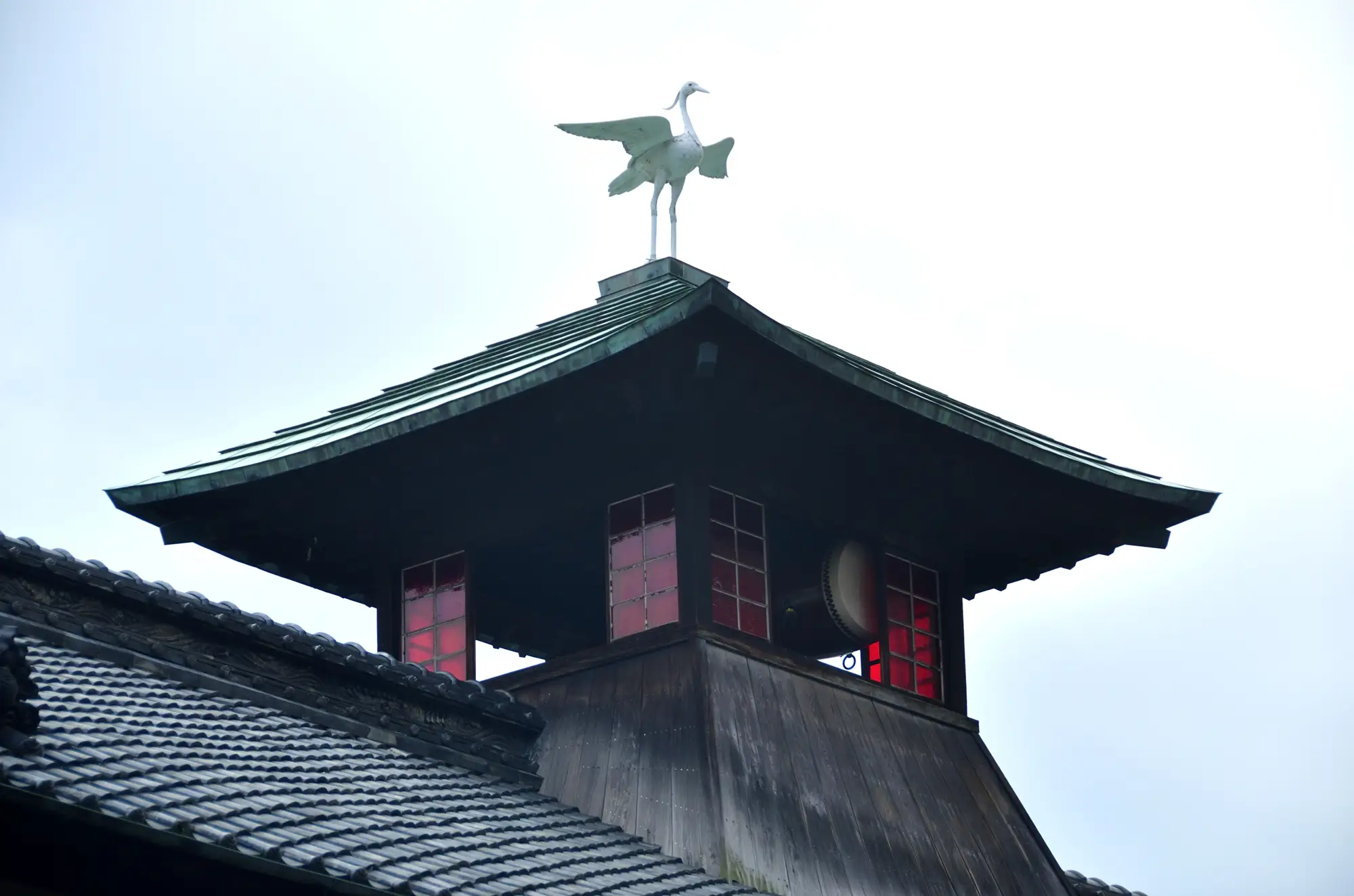
A taiko drum hangs from the Shinrokaku, located on the main roof of the third floor. This drum is struck three times a day in the morning, afternoon, and evening to announce the time of day. When the sun sets and the surrounding gas lamps are lit, the entire building comes to life, creating a magical atmosphere.

The water is free-flowing from the source, with no heating or water added. You can enjoy Japan's oldest onsen in abundance, not only in the bathtub, but also in the hot water from the faucet in the washing area. The smooth water is gentle to the skin and has a skin beautifying effect.
*The Dogo Onsen Honkan is undergoing conservation and repair work until December 2024. Please check the official website for the latest information.
Ginzan Onsen Town,Yamagata
Ginzan Onsen in Yamagata Prefecture is popular for its nostalgic townscape. Wooden onsen ryokans built between the late Taisho and early Showa eras line both banks of the Ginzan River, forming a nostalgic and somewhat nostalgic onsen town. At dusk, gas lamps are lit in the onsen resort area. It is said that the illuminated streets resemble the atmosphere of the movie Spirited Away.
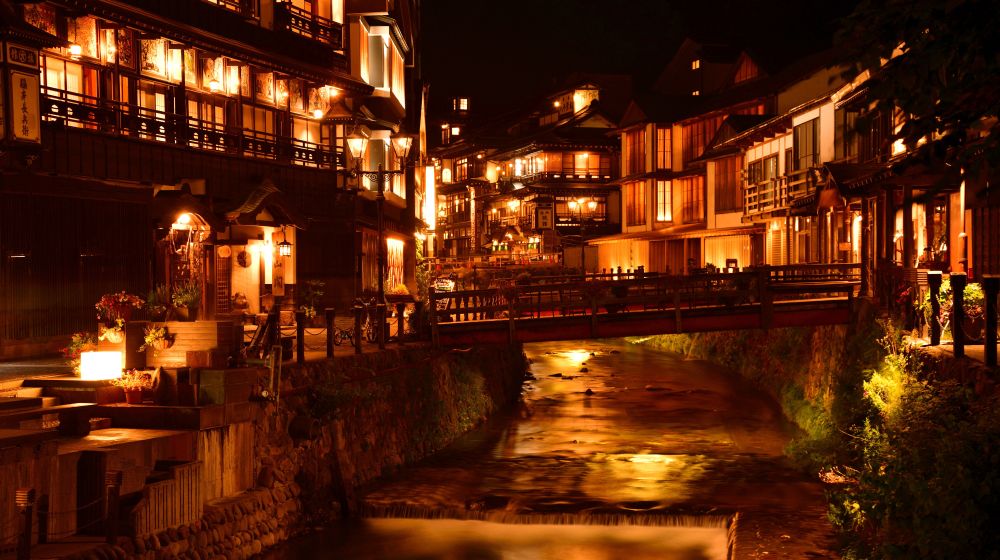
The town of Yinshan Onsen once prospered from the silver mines, and it is said that in 1614, a miner working in the silver mines found an onsen, and in 1630 the silver mines reached their peak. The mines were all closed in 1689, but the town developed as an onsen resort in place of the silver mines. Originally, as a secluded onsen deep in the mountains, local people operated inns and businesses catering to the therapeutic baths. The number of visitors began to increase from the end of the Taisho era (1912-1926) to the beginning of the Showa era (1926-1989), when the Shinkansen bullet train line was extended in 1999, attracting many visitors from all over the country.
The charm of the onsen town is the nostalgic scenery of the ryokan that line both banks of the Ginzan River. At night in winter, the snow-covered streets of the onsen resort town are illuminated by outside lights, making it very magical and beautiful.
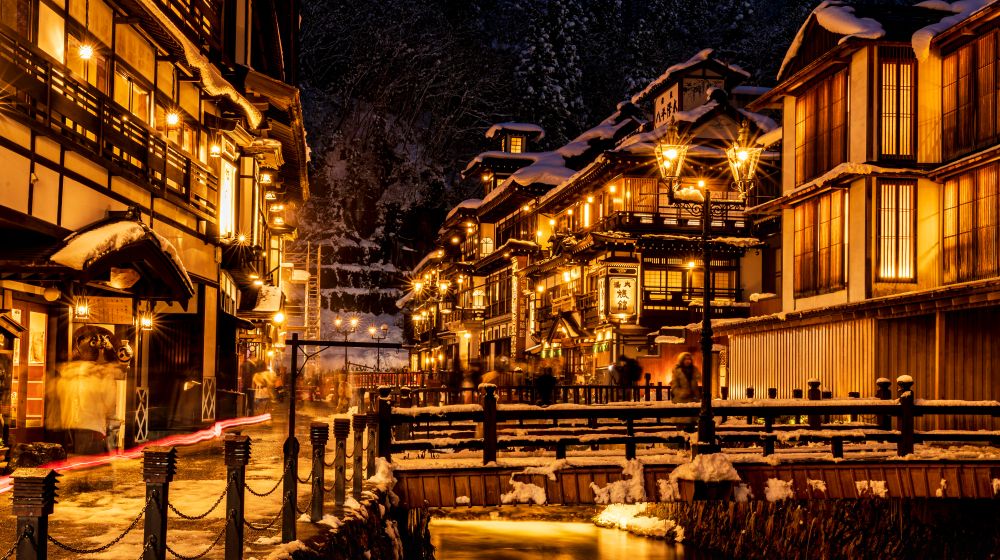
The walls of ryokans are covered with colorful pictures called trowel paintings. Trowel paintings are drawings made by plasterers using plaster mixed with pigments.
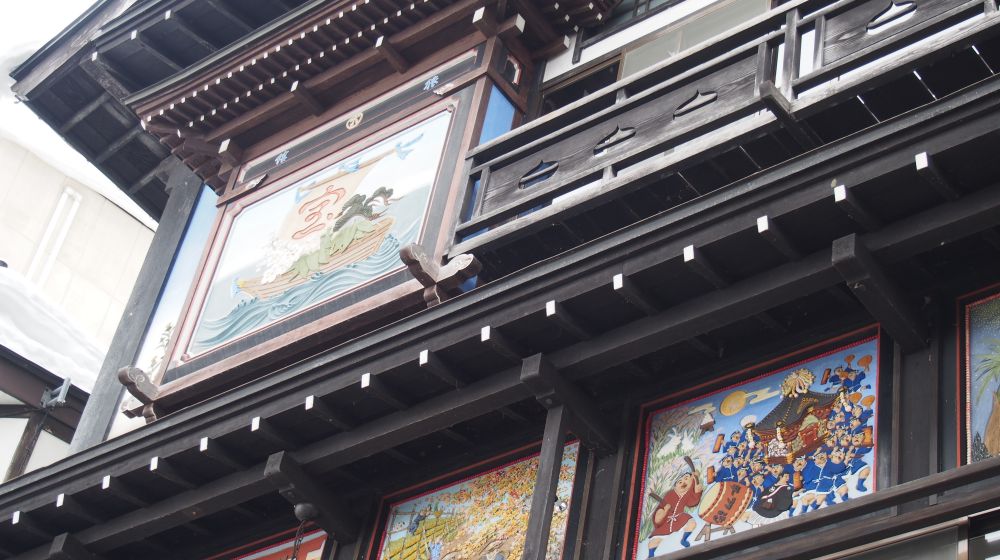
The streets are embedded with tiles with snowflake designs, making it look like a magical onsen resort in a movie. The onsen resort town has restaurants and souvenir shops, so visitors can enjoy eating and shopping. At night, the gas lamps are lit and the town looks just like a movie. The red bridge over the Ginzan River and the rows of inns across the river remind one of a scene from a movie. Beyond the illuminated inns seen from the red bridge, the world of Aburaya seems to exist.
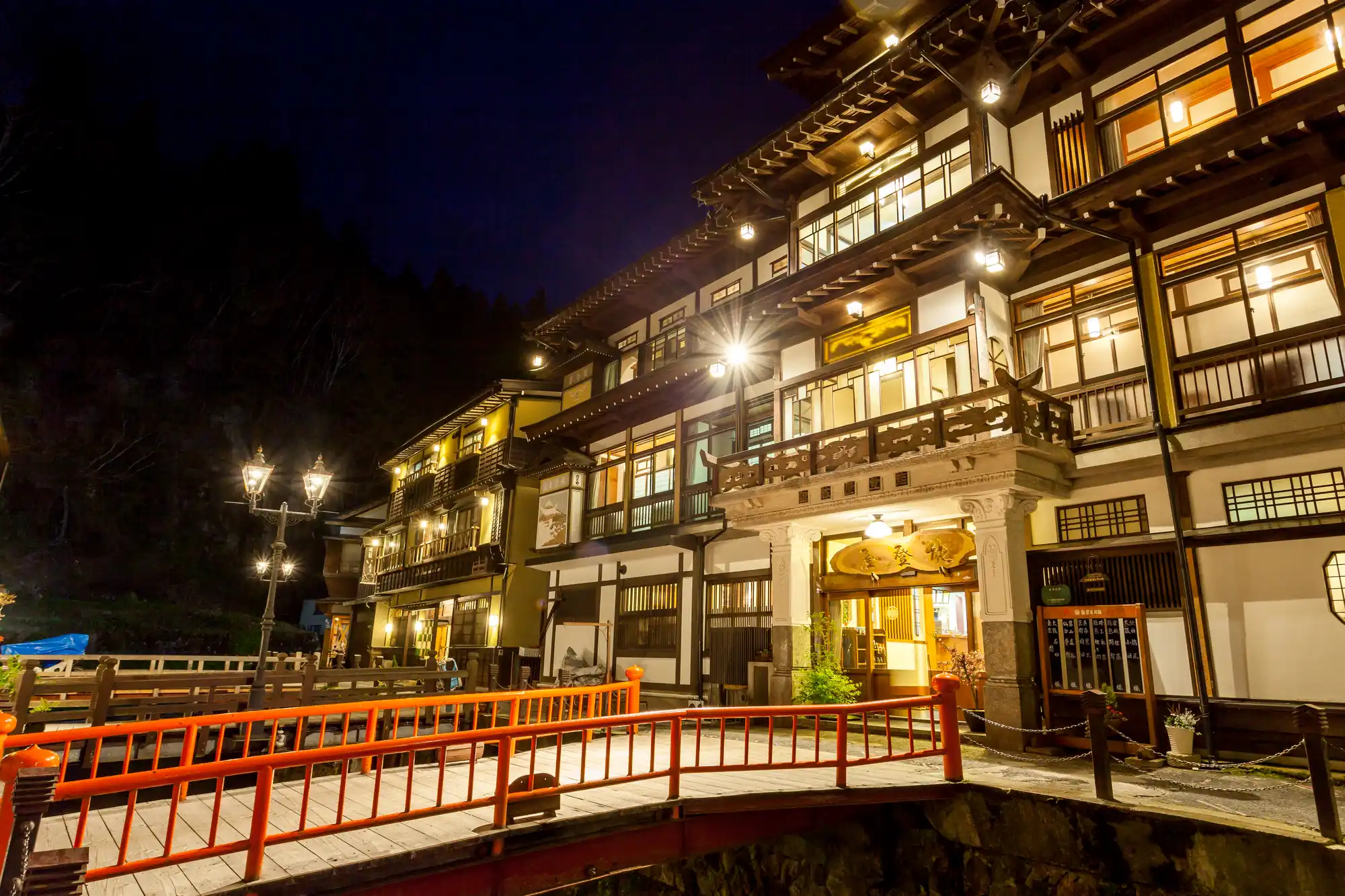
The hot water of Ginzan Onsen is effective in relieving fatigue, improving health, and recovering from illness. The water is clear and colorless, with a slight salty taste and hydrogen sulfide odor. Depending on the season, visitors can enjoy a variety of scenery, such as autumn leaves and snowy landscapes. In winter, visitors can enjoy the luxury of soaking in the open-air baths while viewing the beautiful snowy scenery.
Ikaho Onsen, Gunma
Located in Gunma Prefecture, Ikaho Onsen is a famous onsen with a long history, having been written about in Japan's oldest anthology of waka poems, Manyoshu. The Manyoshu is said to have been compiled around the end of the 8th century. It is assumed that the onsen was already being used as a therapeutic bath by this time.
The symbol of Ikaho Onsen is the 365 stone steps that seem to go on forever. The central area of Ikaho Onsen is also called Ishidangai (Ikaho Stone Steps) , with ryokans and souvenir shops lining both sides of the stone steps.
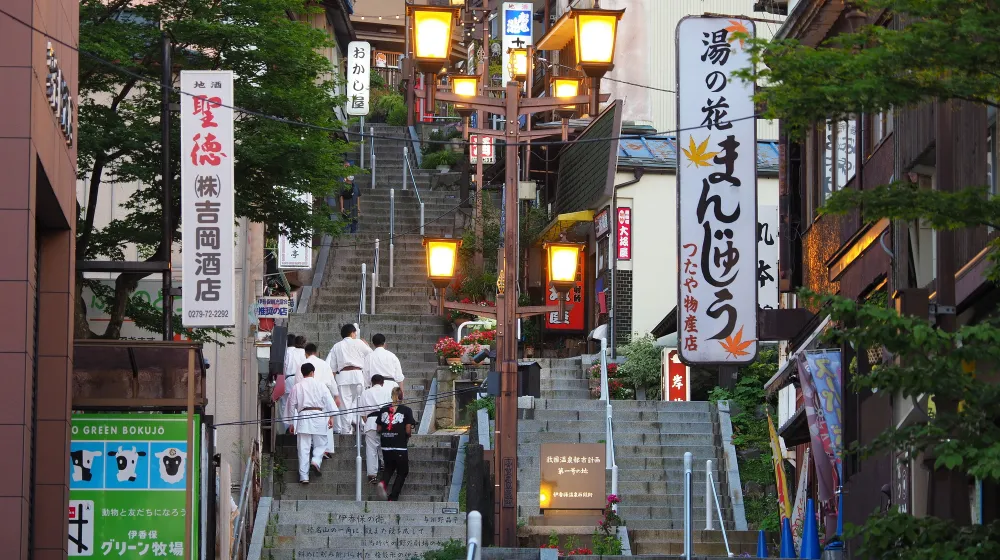
The stone steps lined with inns, souvenir stores, and restaurants are illuminated at night. The fantastic atmosphere of soft light illuminating the stone steps is talked about as being similar to the world of a movie.
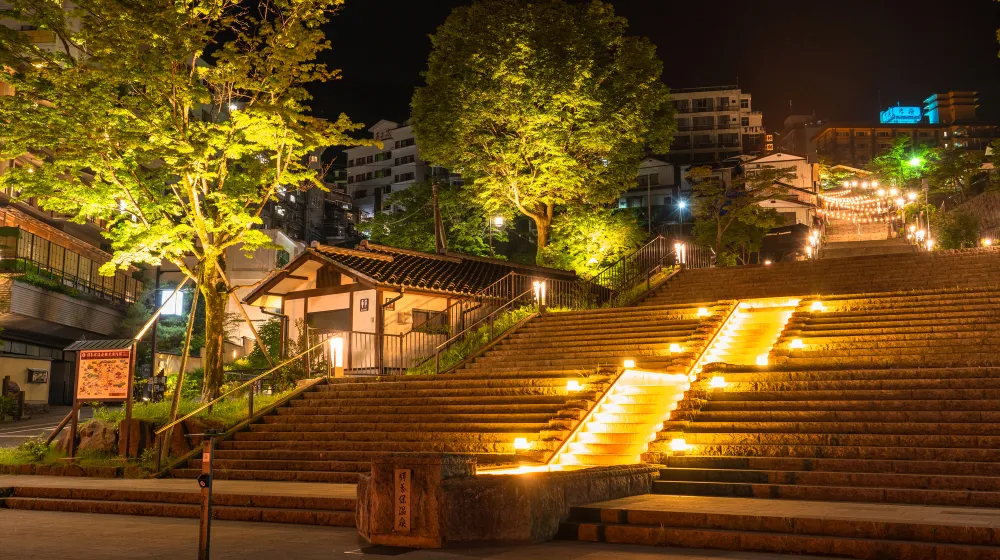
At the top of the stone steps is the Ikaho Shrine. On Yumoto-dori Street, a five-minute walk from the shrine, the vermilion Kajika Bridge spans the river. Kajika Bridge is said to be the model for the red bridge in front of the onsen ryokan "Aburaya" in the movie.
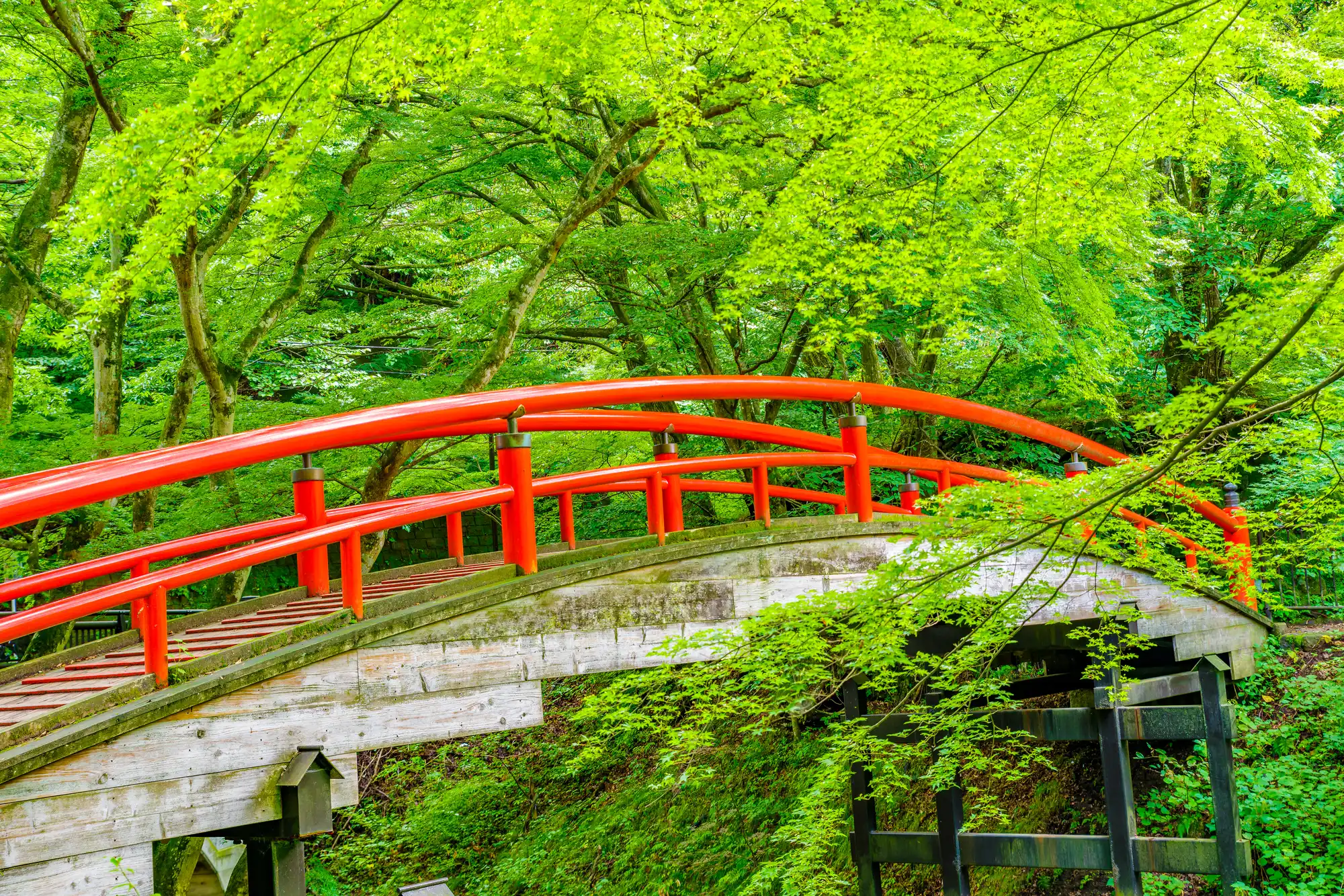
There are two theories about Ikaho Onsen: one says that it was discovered about 1,900 years ago, and the other says that it was discovered by the monk Gyoki (668-749), who lived about 1,300 years ago. In the Edo period (1603-1868), many pilgrims came to Ikaho Onsen for an onsen cure, visiting temples and shrines, and the area began to develop.
The stone staircase was built around 1576. The current stone staircase was extensively renovated over a five-year period beginning in 1980, and in 2010, a new stone staircase was added to the staircase in the hope that the onsen resort would be lively 365 days a year, thus bringing the total number of steps to 365.
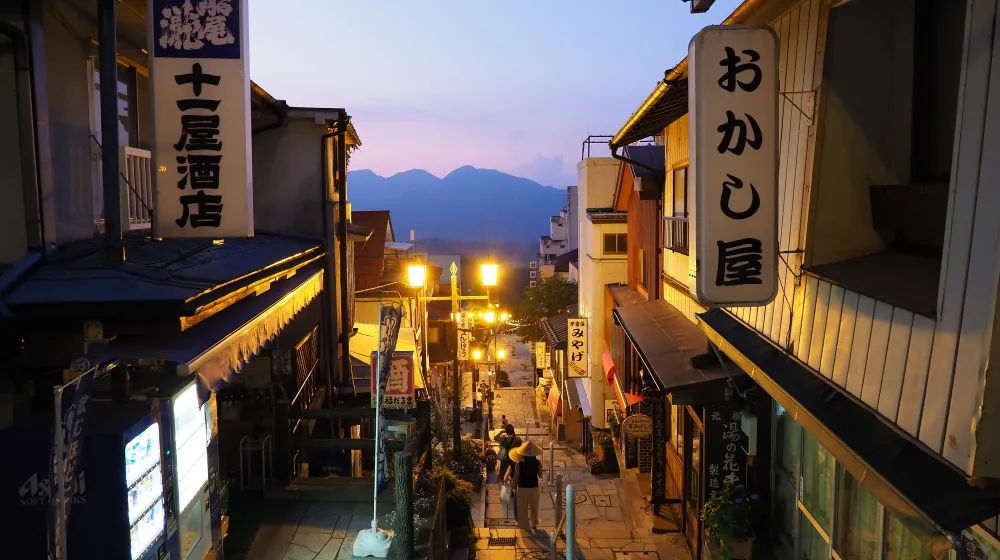
Kajika Bridge is a short wooden bridge with a beautiful vermilion color. The bridge is surrounded by thickly growing maple trees. Kawajika Bridge is also known as a place where visitors can enjoy fresh greenery in spring and autumnal foliage in fall. During the season, the bridge is illuminated at night, creating an ethereal beauty different from that of the daytime.
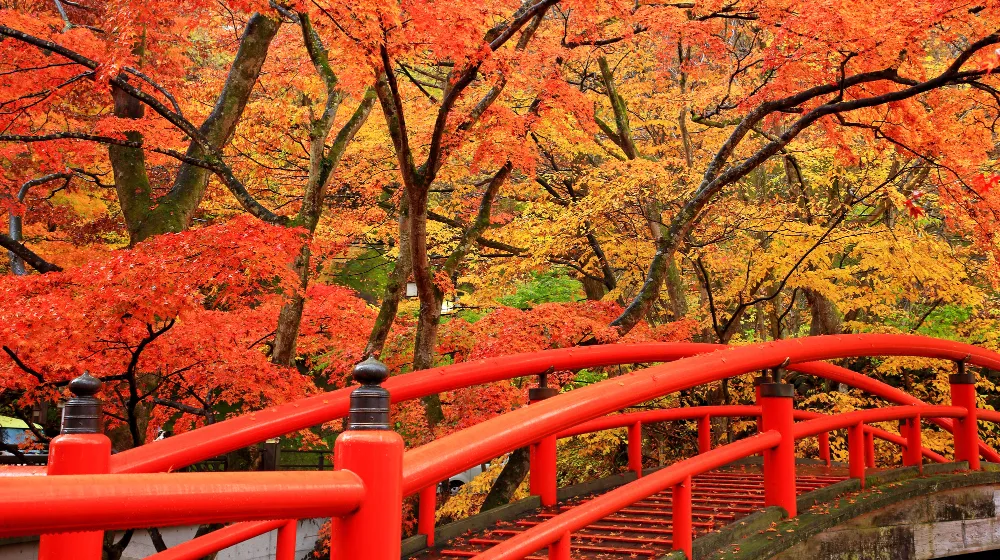
There are two types of onsens in Ikaho Onsen: "Kogane-no-yu" and "Shirogane-no-yu".
"Kogane-no-yu" is a onsen that has been passed down from generation to generation, and was originally the only onsen in Ikaho. Because the water warms the body and stimulates circulation, it has been known as a "fertility Onsen" that is kind to women. The water is clear and colorless when it first gushes out, but when the iron in the water comes into contact with air, it oxidizes and turns brownish-brown.
The "Shirogane-no-yu" is a clear, colorless onsen that was developed in recent years and is effective for improving health and relieving fatigue. It contains metasilicic acid, which is said to promote the metabolism of the skin, and is expected to have a beautifying effect on the skin.
Search by Prefecture
Search by Onsen area
- Hokkaido
- Nagano
- Akita
- Kanagawa
- Yamagata
- Shizuoka
- Gifu
- Hyogo
- Wakayama
- Yamanashi
- Kumamoto
- Oita
- Fukushima
- Tochigi
- Gunma
- Ishikawa
- Shimane
- Ehime
- Saga
- Kagoshima
